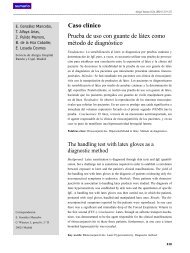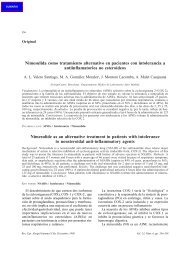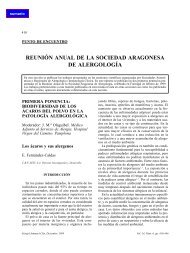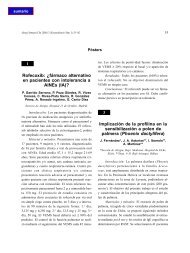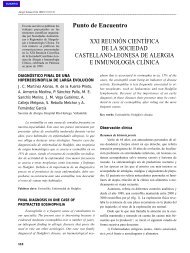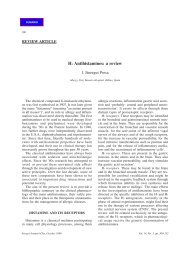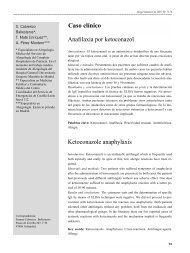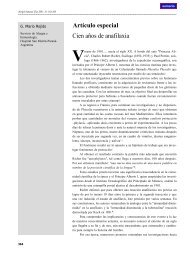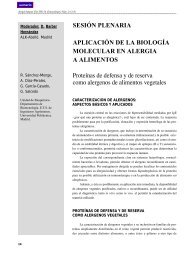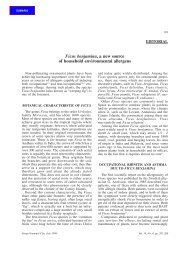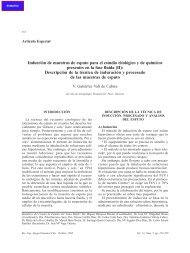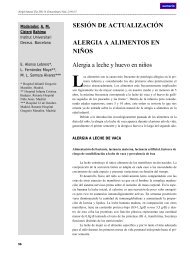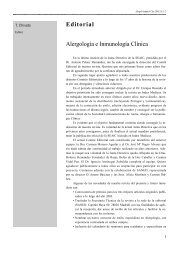Gastroallergic anisakiasis: immediate ... - Revista seaic
Gastroallergic anisakiasis: immediate ... - Revista seaic
Gastroallergic anisakiasis: immediate ... - Revista seaic
You also want an ePaper? Increase the reach of your titles
YUMPU automatically turns print PDFs into web optimized ePapers that Google loves.
Alergol Inmunol Clin 2000;15:230-236<br />
Mª C. López Serrano,<br />
A. Alonso-Gómez,<br />
Á. Moreno-Ancillo 1 ,<br />
Á. Daschner,<br />
J. Suárez de Parga 1<br />
Allergy Section and<br />
1<br />
Endoscopy Unit, "La Paz"<br />
General University Hospital.<br />
Madrid, Spain<br />
Original Article<br />
<strong>Gastroallergic</strong> <strong>anisakiasis</strong>: <strong>immediate</strong><br />
hypersensitivity due to Anisakis simplex<br />
infestation<br />
In Spain, cases of <strong>anisakiasis</strong> were anecdotic up to 1995. In that year, however,<br />
and led by Dr. Fernández de Corres, the Spanish allergologists became<br />
fully aware of Anisakis simplex (AS) because of cases of allergic reaction<br />
after the intake of "presumably" well-cooked fish with positive skin<br />
tests and specific IgE to AS. The fundament of AS allergy appeared to reside<br />
in the heat stability of AS antigens. Following the observation of several<br />
cases of anaphylaxis with AS infestation, a prospective study was set<br />
up in 1997 in the "La Paz" University Hospital. Patients were entered into<br />
the study that came to the Emergency Outpatient Clinic with allergic or<br />
gastrointestinal symptoms after the ingestion of seafoods or fish up to 48<br />
hours earlier. If the gastrointestinal symptoms persisted, a gastroscopy was<br />
performed. Over a period of 18 months, 120 patients were assessed who<br />
complained of allergic symptoms; in 96 of them, AS was actually implicated.<br />
Over those 18 months, and based on the allergic symptoms, 24 patients<br />
were detected in whom one or more parasites were removed from their stomachs<br />
(more parasites detected within 18 months than in the whole of<br />
Spain since 1991). Vinegar-marinated herring and in some cases fresh hake<br />
-presumably well-cooked- were the sources in most of the cases of parasitic<br />
infestation. The authors coined for this condition the term gastroallergic<br />
<strong>anisakiasis</strong> in order to differentiate it from gastric <strong>anisakiasis</strong>, as the hypersensitivity<br />
symptoms after contact with the parasite were more intense and<br />
severe than the gastric ones. The antigenic source appeared to be in most<br />
cases the live parasite, and, furthermore, it appeared to require binding to<br />
the submucosa in order to trigger the hypersensitivity reaction.<br />
The next step in these patients with gastroallergic <strong>anisakiasis</strong> was to carry<br />
out challenge tests with frozen, non-infective parasites. Tolerance was<br />
confirmed in a number of patients, and from then onwards patients were<br />
allowed to eat deep-frozen fish, with no problems ensuing. At that point,<br />
allergy to heat-stable AS proteins appeared to be less frequent than previously<br />
supposed, and it was surmised that the IgE-mediated response corresponded,<br />
in most sensitised patients, to contact (luminal or asymptomatic<br />
parasitic infestations) with the live parasite.<br />
The past history of dietary intake, the clinical features, the skin test responses<br />
and the serial quantitation of AS-specific IgE represent important key points in<br />
the diagnosis. Cases of true Anisakis simplex allergy may indeed exist, but in<br />
the light of the results of this prospective study they appear to be infrequent.<br />
Key words: Anisakis simplex. <strong>Gastroallergic</strong> <strong>anisakiasis</strong>. Prospective study.<br />
230
<strong>Gastroallergic</strong> <strong>anisakiasis</strong><br />
Anisakiasis gastro-alérgica:<br />
hipersensibilidad inmediata debida<br />
a parasitación por Anisakis<br />
simplex<br />
En España, hasta 1995 los casos de <strong>anisakiasis</strong> eran anecdóticos.<br />
Sin embargo, en 1995, los alergólogos españoles, de la<br />
mano del grupo del Dr. Fernández de Corres, llegan al Anisakis<br />
simplex (AS) por casos de reacciones alérgicas tras consumo<br />
de pescado "presumiblemente" bien cocinado y con pruebas<br />
cutáneas e IgE específica a AS positivas. La base de la<br />
alergia al AS parecía estar en la termoestabilidad de antígenos<br />
del AS. Tras observar algunos casos de anafilaxia con<br />
parasitación por AS, en 1997 se inició en el Hospital Universitario<br />
"La Paz" de Madrid un estudio prospectivo. Se introdujeron<br />
pacientes que acudían a Urgencias con síntomas alérgicos<br />
o gastrointestinales tras ingestión de productos de mar,<br />
aceptando pacientes que hubieran tomado el alimento hasta<br />
48 horas antes. Si el cuadro digestivo persistía se realizaba<br />
endoscopia. En 18 meses se evaluaron 120 pacientes que<br />
consultaron por síntomas alérgicos, de los cuales en 96 se implicó<br />
verdaderamente al AS. En esos 18 meses, y sobre la base<br />
de los síntomas de alergia, se detectaron 24 pacientes a los<br />
que se extrajeron del estómago uno o más parásitos (más parásitos<br />
hallados en sólo 18 meses que desde 1991 en España).<br />
El boquerón en vinagre y, en algunos casos, la merluza fresca,<br />
presumiblemente bien cocinada, fueron la fuente de la<br />
mayoría de las parasitaciones. Los autores denominaron a esta<br />
entidad <strong>anisakiasis</strong> gastro-alérgica, diferenciándola de la<br />
<strong>anisakiasis</strong> gástrica dado que los síntomas de hipersensibilidad<br />
tras el contacto con el parásito eran más intensos e importantes<br />
que los gástricos. Parecía que, en su mayoría, era el<br />
parásito vivo la fuente antigénica, y, más aún, que necesitaba<br />
fijarse a la submucosa para producir la reacción de hipersensibilidad.<br />
El paso siguiente en estos pacientes con <strong>anisakiasis</strong><br />
gastro-alérgica fue la provocación con parásitos congelados<br />
no infectivos. Se confirmó su tolerancia en varios pacientes,<br />
y a partir de entonces al resto se les permitió comer pescado<br />
congelado sin suceder ningún problema. En ese punto, la<br />
alergia a proteínas termoestables del AS parecía menos frecuente<br />
de lo previamente supuesto, y se intuía que la respuesta<br />
mediada por IgE en la mayoría de los pacientes sensibilizados<br />
correspondía a contactos (parasitaciones en forma<br />
luminal o asintomáticas) con el parásito vivo. El antecedente<br />
dietético, la clínica, la respuesta a las pruebas cutáneas y la<br />
medición seriada de IgE específica a AS son claves importantes<br />
para el diagnóstico. Puede que existan casos de verdadera<br />
alergia a AS, pero a la vista de los resultados del presente<br />
estudio prospectivo deben ser infrecuentes.<br />
Palabras clave: Anisakis simplex. Anisakiasis gastro-alérgica.<br />
Estudio prospectivo.<br />
INTRODUCTION<br />
Anisakis simplex (AS) is a parasitic helminth included<br />
in the Class Nematoda. Leucckart, in 1876, was the<br />
first to describe a case of human infestation, in a Greenland<br />
child. In 1960, Van Thiel identified the infesting parasite<br />
as the stage III larva of Anisakis 1-5 . The taxonomy of<br />
the genus Anisakis is a complex one. It is included in the<br />
Class Nematoda, subclass Secernentea, order Ascaridida,<br />
suborder Ascaridina, superfamily Ascaridoidea, family<br />
Anisakidea. The subfamily Anisakinae includes the genus<br />
Anisakis, with four recognised species: Anisakis simplex,<br />
Anisakis physeris, Anisakis typica and Anisakis schupakovi<br />
5 . All these species are usually parasitic in the stomach of<br />
marine mammals. The life cycle of the parasite may include<br />
one or more intermediate hosts. The ova of the adult parasites<br />
are shed with the marine mammal’s faeces into the<br />
water and continue there their development up to the stage<br />
of infective larva. At this stage, the larva is some 0.35 mm<br />
long and is ingested by a first host, usually planktonic<br />
crustaceans, in which it develops further and attains a size<br />
of about 5 mm. After a fish or a cephalopod has ingested<br />
the crustacean host, the larvae develop into their third larval<br />
stage and grow to about 2-3 cm in length. These larvae<br />
may pass several times from one fish or cephalopod to<br />
another one, but they do not complete their evolutive cycle<br />
until they arrive into the stomach of a marine mammal.<br />
There they attach themselves to the gastric wall and evolve<br />
into the fourth larval stage and then into adult parasites,<br />
thus completing their life cycle 1-5 .<br />
Man is an aberrant host, as the larva cannot attain sexual<br />
maturity in this environment. Man becomes infested<br />
upon ingesting the larvae in raw or undercooked fish, but<br />
also in smoked fish, semi-preserves, dried or marinated<br />
fish (particularly vinegar-marinated), ceviche (a Peruvian<br />
lemon-marinated fish preparation) or Japanese culinary delicacies<br />
such as sushi or sashimi, which are prepared with<br />
raw fish. The number of fish species reported to be pos-<br />
231
M. a C. López Serrano, et al<br />
sibly infested is a veritable host, and includes cod, sardine,<br />
herring, mackerel, salmon, hake, pollack, anchovy, whiting,<br />
bonita and horse mackerel; the most frequently infested<br />
cephalopod is the squid 6-9 .<br />
Parasitic infestation of man by the live larvae is termed<br />
<strong>anisakiasis</strong> or anisakidosis, and is particularly common<br />
among the Japanese because of their habit of raw fish<br />
consumption 10,11 .<br />
By the year 1995, human Anisakis-related diseases<br />
were differentiated into a number of clinical forms depending<br />
on the affected region of the digestive tract. The<br />
luminal form was considered to be caused only by Phocanema<br />
larvae and to constitute a lesser stage in which<br />
only asymptomatic adherence of the larvae occurred. In<br />
these cases, the larvae die within a period of weeks and<br />
are expelled with the faeces 12 . A further form was gastric<br />
<strong>anisakiasis</strong>, caused by stage III larvae and characterised<br />
by epigastric pain episodes 13-16 . If the parasite was not extracted,<br />
the disease could progress towards the invasive<br />
forms of subacute or chronic <strong>anisakiasis</strong> 17-20 . There had<br />
also been some reports of polyarthritis 21,22 and some rare<br />
cases of invasion of other organs such as the lung, liver,<br />
spleen and pancreas 23 . In these cases of advanced <strong>anisakiasis</strong>,<br />
IgE and eosinophils had been implicated in the<br />
pathogenesis of the local lesions caused by the parasite<br />
16,24-29 . Only occasionally had localised maculopapular<br />
lesions or generalised urticaria been reported in these patients<br />
13,23,30 .<br />
At that time, and up to 1996, many cases had already<br />
been reported in the Netherlands and occasional ones in<br />
France, the United Kingdom and the USA 3,4,11,20,31,32 . In<br />
Spain, only anecdotal cases of <strong>anisakiasis</strong> had been published<br />
between 1991 and 1996 21,33-35 .<br />
In 1995, Spanish allergologists finally began paying<br />
attention to Anisakis-induced disease because of reported<br />
cases of allergic reactions after the intake of presumably<br />
well-cooked fish in association to positive skin tests and<br />
specific IgE for Anisakis, while the investigations were negative<br />
for the fish supposedly involved in the reaction. Some<br />
authors postulated that the fundament of Anisakis simplex<br />
allergy was the heat-stability of a number of antigens<br />
that might be able to bind to the patients’ IgE and trigger<br />
hypersensitivity symptoms upon the ingestion of cooked<br />
fish 38-40 .<br />
After having observed some cases of anaphylaxis<br />
with Anisakis simplex infestation 42 , a prospective study was<br />
begun in 1997 at the "La Paz" University Hospital in Madrid<br />
(Spain).<br />
MATERIAL AND METHODS<br />
Patients were entered into the study who were seen<br />
at the Emergency Outpatient Clinic because of<br />
allergic or gastrointestinal symptoms after the ingestion<br />
of fish or seafood, irrespective of the preparation,<br />
and including patients who had eaten the suspect food<br />
up to 48 hours earlier. Endoscopy was performed if the<br />
digestive symptoms persisted for over 6-8 hours. In all<br />
patients entered, skin tests were performed with Anisakis<br />
extract, with a panel of different fishes and with<br />
the particular fish or seafood apparently involved in<br />
the reaction. The total serum and fish- and Anisakis<br />
simplex-specific IgE levels were also measured during<br />
the acute episode, and the total IgE and Anisakisspecific<br />
IgE were again measured one month after the<br />
reaction.<br />
RESULTS<br />
Over a period of 18 months, 120 patients consulting<br />
because of allergic symptoms were studied; in 96 of them<br />
Anisakis simplex was actually involved. The associated digestive<br />
symptoms were mild or moderate in most patients,<br />
so that endoscopy was performed only in 47 of them. In<br />
that period 24 infested patients were detected in whom<br />
one or more parasites were removed from the stomach at<br />
endoscopy.<br />
The patient population was divided into three<br />
groups:<br />
1) Patients who had undergone endoscopy and were<br />
actually infested.<br />
2) Patients who had undergone endoscopy and were<br />
not infested.<br />
3) Patients who had not undergone endoscopy.<br />
Vinegar-marinated anchovies and, in some cases,<br />
presumably well-cooked fresh hake were the sources of<br />
most parasitic infestations.<br />
The latency period of the allergic symptoms was variable,<br />
with a mean latency of ca. 6 hours but with a range<br />
between minutes and over 24 hours, and with no differences<br />
between the three groups.<br />
In many cases the digestive symptoms had already<br />
subsided, and endoscopy was not performed.<br />
The total serum and specific IgE levels were significantly<br />
increased one month after contact with the parasite<br />
in all three groups.<br />
232
<strong>Gastroallergic</strong> <strong>anisakiasis</strong><br />
The statistical analysis of the characteristics of the<br />
three patient groups suggests that they were composed of<br />
similar patients.<br />
CHALLENGE TESTS AND LATER DIET<br />
Over the time of the study no clearly defined cases<br />
were seen of patients having had symptoms either with<br />
deep-frozen fish (industrial preparations) or with sufficiently<br />
cooked fish preparations. It is an axiom in Allergology<br />
that, when doubts arise as to a given allergen being<br />
the cause of a given reaction, challenge tests with that<br />
allergen are proposed, besides the usual in vitro assessments<br />
and skin tests.<br />
Live parasites were frozen until they became non-infective.<br />
Challenge tests were then performed, initially giving<br />
from 11 to 20 parasites to a total of 20 out of the 96<br />
patients, with negative results. The challenge tests were<br />
thereupon interrupted, and the remainder of the patients<br />
were allowed to eat deep-frozen fish or seafoods; the tolerance<br />
was repeatedly checked in successive six-monthly<br />
visits and up to the time of writing. In a total of 76 patients<br />
so investigated, no problem related to the ingestion<br />
of deep-frozen fish has been detected until now. Twenty<br />
patients were lost to follow-up, as they did not attend the<br />
successive review visits.<br />
DISCUSSION<br />
In 1995, the conditions caused by Anisakis simplex<br />
were differentiated into a number of clinical forms according<br />
to the digestive tract region involved. Gastric <strong>anisakiasis</strong><br />
was caused by stage III larvae; in this particular<br />
form the larvae reach the submucosa through the action of<br />
peptidases, and induce epigastric pain due to the inflammatory<br />
reaction of the viscus wall 13-16 . If the parasite(s) were<br />
not extracted, the condition progressed to the subacute or<br />
chronic <strong>anisakiasis</strong> form. The larvae might be able to traverse<br />
the gastric or intestinal wall; the parenteral invasive<br />
form resulting might cause granulomata or abscessification<br />
in association to eosinophilia, fever, diarrhoea and abdominal<br />
pain. This situation might mimic acute appendicular<br />
episodes, but true appendicitis and episodes of intestinal<br />
obstruction had also been reported 17-20 . Infrequent cases of<br />
polyarthritis 21,22 and still rarer ones of distant organ invasion<br />
(lung, liver, spleen and pancreas) 23 had also been described.<br />
In these cases of <strong>anisakiasis</strong>, both the IgE and the<br />
eosinophils had been implicated in the aetiopathogenesis<br />
of the local lesions caused by the attachment of the parasites<br />
16,24-29 . In the course of a first contact, the parasitic infestation<br />
might induce a mild chronic inflammatory reaction<br />
in the mucosa. The acute forms would then be due<br />
to type I or type III hypersensitivity reactions in the digestive<br />
tract in the course of secondary infestations 16,29,30 .<br />
Only occasionally had localised maculopapular lesions<br />
and generalised urticaria been reported in these patients<br />
13,23,30 .<br />
In Europe, and up to 1996, over 100 cases had been<br />
reported in the Netherlands (collected between 1995 and<br />
1968) 3,4,11 ; and there had been occasional case reports in<br />
France, the United Kingdom and the USA from 1975 onwards<br />
11,20,31,32 . In Spain, some six cases had been reported<br />
between 1991 and 1996; cases of <strong>anisakiasis</strong> were anecdotal<br />
at that time 21,33-35 , but from that year onwards the number<br />
of reports increased progressively.<br />
In 1995 the Spanish allergologists were made aware<br />
of Anisakis-induced disease through cases of allergic reactions<br />
after the ingestion of presumably well-cooked fish<br />
with positive skin tests and specific IgE to Anisakis while<br />
the studies were negative for the fish supposedly involved<br />
in the reaction 36-41 . The reports of Anisakis simplex sensitisation<br />
multiplied, and some confusion arose regarding the<br />
value of some positive tests in patients describing no allergic<br />
reaction at all, and of course no previous infestation<br />
by Anisakis simplex (ca. 13%). For some authors, the basis<br />
of Anisakis simplex allergy was to be found in the heatstability<br />
of some antigens of the parasite, which would be<br />
able to bind to the patients’ IgE and trigger hypersensitivity<br />
symptoms upon the ingestion of cooked fish 38-40 .<br />
After having observed a number of cases of anaphylaxis<br />
associated to Anisakis simplex infestation 42 , a prospective<br />
study was initiated at the "La Paz" University<br />
Hospital in Madrid. Over a period of 18 months 120 patients<br />
were assessed, who had consulted because of allergic<br />
symptoms (in many cases life-threatening anaphylaxis<br />
or anaphylactic shock); in 96 of them Anisakis simplex<br />
was truly implicated in the reactions 43-49 . The associated digestive<br />
symptoms were mild or moderate in most patients,<br />
and for this reason only 47 patients underwent endoscopy.<br />
To our surprise, over those 18 months, and based on the<br />
allergic symptoms, 24 patients were detected in whom one<br />
or more parasites were removed from their stomachs (almost<br />
more parasites found over a period of 18 months<br />
than in the whole of the Spanish literature between 1991<br />
233
M. a C. López Serrano, et al<br />
and that time). The very typical "boquerón en vinagre"<br />
(vinegar-marinated anchovies) and in some cases presumably<br />
well-cooked fresh hake were the sources of most<br />
infestations. The latency period of the allergic symptoms<br />
was quite variable, ranging between a few minutes and<br />
over 24 hours. The average latency for the digestive<br />
symptoms was similar, although they tended to occur<br />
slightly earlier. No endoscopy was performed when the digestive<br />
symptoms had already subsided at the time of seeing<br />
the patient. The total serum IgE and the specific IgE<br />
were found to be significantly increased one month after<br />
the index contact 45,47,48 .<br />
The statistical analyses suggested that the study population<br />
was formed by similar patients, in whom in some<br />
cases the parasite became attached to the gastric mucosa<br />
for a time sufficient for triggering the allergic reaction;<br />
however, its trend to then detach and be expelled does not<br />
allow it to be detected in time at endoscopy. The authors<br />
termed this particular condition gastroallergic <strong>anisakiasis</strong>"<br />
42-51 , differentiating it from gastric <strong>anisakiasis</strong>, as the<br />
hypersensitivity symptoms after contact with the parasite<br />
were more intense and severe than the gastric ones. However,<br />
in the course of the study period and also in a review<br />
of previous suggestive cases from our Hospital no cases<br />
were detected in which symptoms had arisen after consuming<br />
industrially deep-frozen or sufficiently cooked fish.<br />
In the light of this observation, it would appear that in<br />
most cases the live parasite had been the antigen source,<br />
and furthermore, that the parasite required attachment to<br />
the submucosa in order to elicit the hypersensitivity reaction.<br />
At this point in time, true allergy to heat-stable proteins<br />
of Anisakis simplex appeared to be less frequent than<br />
previously supposed, and it was thought that the IgE-mediated<br />
response corresponded, in most of the sensitised patients,<br />
to previous contacts with the live parasite (transient<br />
infestation either in the luminal form or clinically asymptomatic).<br />
Adhering to the diagnostic procedure usually applied<br />
in Allergology whenever there is doubt about a given antigen<br />
as the cause of a given reaction, the next step in these<br />
patients with gastroallergic <strong>anisakiasis</strong> was challenge testing<br />
with non-infective frozen parasites 50 . Tolerance was<br />
confirmed in a number of patients, and from then onwards<br />
the remainder of the patients were allowed to eat deep-frozen<br />
fish, with no untoward problems arising.<br />
The immunologic and inflammatory response to the<br />
parasite may explain most of the clinical symptoms and<br />
signs in <strong>anisakiasis</strong>. The parasite avails itself of proteases<br />
in order to achieve attachment to the gastrointestinal mucosa.<br />
It is quite possible that local factors such as preexisting<br />
mucosal lesions, changes in gastrointestinal motility<br />
or changes in the environmental pH may influence not<br />
only the parasite’s ability to become attached but also the<br />
duration of such attachment end even the possibility –rather<br />
more remote, but already reported– of transmucosal<br />
penetration. Once attached to the submucosa, the secretion<br />
of proteins by the parasite sets in motion the defensive<br />
response of the rich gastrointestinal lymphoid tissue. The<br />
type of anti-parasite response in this case is predominantly<br />
Th2. Thus, the expression pattern of cytokines such as IL-4<br />
and IL-5 leads to chemotactic attraction of eosinophils and<br />
to intestinal lymphoid tissue hyperplasia and also to a stimulation<br />
to IgE production, with the subsequent increase<br />
of the total and parasite-specific IgE levels 16,24-29,48 . Other<br />
immunoglobulins are also produced and may in some cases<br />
lead to immune-complex-mediated responses.<br />
The symptomatology of <strong>anisakiasis</strong> would be mediated<br />
mainly by this inflammatory response and in some cases<br />
by the penetration of the parasite. If the response is<br />
maintained only in the local gastric environment, acute<br />
gastric <strong>anisakiasis</strong> will ensue. Further to this, the already<br />
initiated immune response may induce distant hypersensitivity<br />
symptoms mediated by IgE –and therefore allergic–,<br />
which seem to be rather frequent: gastro-allergic <strong>anisakiasis</strong>.<br />
Immune complexes might explain the articular manifestations<br />
sometimes observed but, in the light of the published<br />
reports, are rather infrequent. Subacute or chronic<br />
<strong>anisakiasis</strong> is usually seen at the intestinal level, and the<br />
inflammation (even though the parasite may have already<br />
been expelled with the faeces) may induce mucosal changes<br />
leading even to an acute abdomen. If the parasite still<br />
remains within the digestive tract wall, or even achieves<br />
its penetration, surgery will be required in most of these<br />
cases. In very rare cases, penetration of the parasite leads<br />
to its apparition in exceptional locations such as the lung,<br />
the liver, the spleen or the pancreas.<br />
In the cases of subacute or chronic <strong>anisakiasis</strong>, distant<br />
hypersensitivity manifestations are infrequent.<br />
The previous history of fish or seafood ingestion, the<br />
clinical manifestations, the endoscopic and radiologic examination,<br />
the response to the skin tests and the serial measurements<br />
of the specific IgE Anisakis simplex antibodies<br />
are important clues for the diagnosis.<br />
Cases may exist of true Anisakis simplex allergy but,<br />
in the light of the results of this prospective study, they<br />
234
<strong>Gastroallergic</strong> <strong>anisakiasis</strong><br />
should not be particularly frequent. Challenge tests with<br />
non-infective parasites should be the clue for diagnosis in<br />
these cases, keeping in mind the importance of the subsequent<br />
dietary restrictions 50,52 .<br />
The best therapeutic measure for <strong>anisakiasis</strong> is<br />
prophylaxis and prevention, avoiding the ingestion of raw<br />
fish or of fish prepared in ways that do not extinguish the<br />
viability of the larvae. Industrial smoking should achieve<br />
temperatures of at least 60ºC for at least 10 minutes if it is<br />
to be considered safe. The larvae may withstand conditions<br />
such as 50 days at 2ºC, 60 days in vinegar, 6 days in formaldehyde,<br />
or 2 hours at –20ºC. however, they are unable<br />
to resist over 2 minutes at temperatures in excess of 60ºC.<br />
The infestation rates of fish are high, ranging from<br />
40 to 80% of the pieces examined depending on the species<br />
6-9 . The prophylactic measure imposed by law within<br />
the European Union, that is to compulsorily deep-freeze<br />
any fish destined to commercialisation for raw consumption<br />
to –20ºC for at least 24 hours, has dramatically reduced<br />
the incidence of <strong>anisakiasis</strong> in many regions in Europe.<br />
In Spain, the main problems resides in the lack of<br />
information on the side of the home cooks or of the restauration<br />
industry, so that the fish that has been bought<br />
and prepared either raw or undercooked not necessarily<br />
has complied with that ruling.<br />
The observation by the Allergologists has only made<br />
manifest (and put a name) one disease condition that has<br />
probably existed for a long time 42-51 . Because of this renewed<br />
vigilance, there is a continuing increase of the number<br />
of cases reported in Spain, where preventive rulings<br />
that do exist are not sufficiently applied.<br />
REFERENCES<br />
1. Gibson DI. The systematics of Ascaridoid Nematodes. A current<br />
assessment. En Stone AR, Platt HM, Khalil LF eds. Concepts in nematode<br />
systematics. London: Academic press, 1983; 321-338.<br />
2. Cocheton JJ, Cabou I, Lecomte I. Anisakiase et infections par les<br />
Anisakidés. Ann Med Interne 1991; 142: 121-31.<br />
3. Van Thiel PH. Anisakis. Parasitology 1960; 53: 16.<br />
4. Van Thiel PH, Kuipers FC, Roskam RT. A nematode parasitic to<br />
herring causing acute abdominal syndromes in man. Trop Geogr Med<br />
1962; 2: 97-113.<br />
5. Cheng TC. Parasitología general. Superfamilia Heterocheloidea.<br />
Madrid. Ed. AC 1978; 6411-6451.<br />
6. Pereira Buena JM. Algunos aspectos de la epidemiología y prevención<br />
de la <strong>anisakiasis</strong>. Revision de biología del parásito; <strong>anisakiasis</strong>,<br />
diagnóstico, tratamiento, estudio de prevalencia de parasitación de las<br />
especies de pescado de consumo en nuestro país y normativa sanitaria.<br />
Eds: Consejería de de Sanidad y Bienestar Social. Junta de Castilla<br />
y León (Government of Castile, Spain). Valladolid. 1992, 1-56.<br />
7. Orecchia P, Paggi L, Mattiuc S, Di Cave D, Catalini N. Infestazione<br />
da larva di Anisakis simplex e Anisakis physeteris in spacie ittiche<br />
dei mari italiani. Parassitologia 1989; 31: 37-43<br />
8. Huang W. Anisakidés et anisakidoses humaines: enquéte sur les<br />
anisakidés des poissons commerciaux du marché parisien. Ann Parasitol<br />
Hum Comp 1988; 63: 197-208.<br />
9. Sanmartín ML, Quintero P, Iglesias, et al. Nematodos parásitos en<br />
peces de las costas gallegas. Madrid: Díaz de Santos 1994.<br />
10. Ishikura H, Kikuchi K, Nagasawa K, Ooiwa T, Takamiya H, Sato<br />
N, Sugane K. Anisakidae and anisakidosis. Progress in clinical Parasitology<br />
1994; 3: 43-101.<br />
11. Bouree P, Paugam A, Petithory JC. Anisakidosis: report of 25<br />
cases and review of th literature. Comp Immunol Microbiol Infect Dis<br />
1995; 18: 75-84.<br />
12. Kliks MM. Anisakiasis in the western United Estates: four new cases<br />
reports from California. Am J Trop Med Hyg 1983; 32: 526-532.<br />
13. Sugimachi K, Inokuchi K, Ooiwa T, Fujino T, Ishii Y. Acute gastric<br />
Anisakiasis. Analysis of 178 cases. JAMA 1985; 253: 1012-1013.<br />
14. Muraoka A, Suehiro I, Fujii M, et al. Acute gastric Anisakiasis : 28<br />
cases during the last years. Dig Dis Sci 1996; 41: 2362-2365.<br />
15. Kakizoe S, Kakizoe H, Kakizoe K, Kakizoe Y, Maruta M, Kakizoe<br />
T, Kakizoe S. Endoscopic findings and clinical manifestation of gastric<br />
Anisakiasis. Am J Gastroenterol 1995; 90: 761-763.<br />
16. Asaishi K, Nishino C, Ebata T, Totsuka M, Hayasaka H, Suzuki<br />
T. Studies on the etiologic mechanism of <strong>anisakiasis</strong>. 1) Immunological<br />
reactions of digestive tract induce by Anisakis larvae. Gastroenterol<br />
Jpn 1980; 15: 120-127.<br />
17. Matsui K, Lida M, Kimura M, et al. Intestinal Anisakiasis: Clinical<br />
and radiologic features. Radiology 1985; 157: 299-302.<br />
18. Appleby D, Kapoor W, Karpf M, et al. Anisakiasis nematode infestation<br />
producing small bowell obstruction. Ach Surg 1982; 117:<br />
836-840.<br />
19. Kim LS, Lee YH, Kim S, Park HR, Cho SY. A case of <strong>anisakiasis</strong><br />
causing intestinal obstruction. Kisaengchunghak Chapchi 1991; 29:<br />
93-96.<br />
20. Pinkus GS, Coodlige C. Intestinal Anisakiasis. First case report<br />
from North America. Am J Med 1975; 59:1: 114-120.<br />
21. Arenal Vera JJ, Marcos Rodríguez JL, Borrego Pintado MH, Bowakin<br />
Dib W, Castro Lorenzo J, Blanco Álvarez JI. Anisakiasis aguda<br />
como causa de apendicitis aguda y cuadro reumatológico: primer caso<br />
en la literatura médica. Rev Esp Enf Digest 1991; 79: 355-358.<br />
22. Fabresse FX, Essioux H, Meiran M, Larroque P, Celton H. Polyarthrite<br />
de l'anisakiase. Premiére cas. Press Med 1984; 13: 1004-<br />
1008.<br />
23. Sakanari JA, Mckerrow JH. Anisakiasis. Clin Microbiol Rev<br />
1989; 2: 278-284.<br />
24. Miyazato I. Studies on the eosinophilic granuloma formation in<br />
parasitic infections with special reference to the experimental gastric<br />
<strong>anisakiasis</strong>. Med J Kuiki Univ 1980; 5: 157-180.<br />
25. Kuipers FC. Eosinophilic phlegmonous inflamation of the alimmentary<br />
tract caused by a parasite from the herring. Path Microbiol<br />
(Basel) 1964; 27: 295-301.<br />
26. Huang W, Camus D, Levy D, Bussiepas J. Les anisakidoses<br />
humaines: identification d'antigénes parasitaires spécifiques et<br />
production d'anticorps monoclonaux. Proceedings of the 7th In-<br />
235
M. a C. López Serrano, et al<br />
ternational congress of Parasitology. Bull Soc Fr Parasitol 1990; 8:<br />
1011.<br />
27. Iglesias R, Leiro J, Ubeira FM, Santamarina MT, San Martín ML.<br />
Anisakis simplex: antigen recognition and antibody production in experimentaly<br />
infected mice. Parasite Immunol 1993; 15: 243-250.<br />
28. Akao N, Ohyama T, Kondo K. Immunoblot analysis of serum<br />
IgG, IgA and IgE responses against larval excretory-secretory antigens<br />
of Anisakis simplex in patients with gastric <strong>anisakiasis</strong>. J Helminthol<br />
1990; 64: 310-318.<br />
29. Petithory JC, Lapierre J, Rousseau M, Clique MT. Diagnostic serologique<br />
de l'anisakiase (granulome eosinophile digestif par precipitation<br />
en milieu gelifie (Ouchterlony, électrosynérése, immunoélectrophorése).<br />
Med Mal Infect 1986; 3: 157-162.<br />
30. Asaishi K, Nishino C, Totsuka M, Hayasaka H, Suzuki T. Studies<br />
on the etiologic mechanism of <strong>anisakiasis</strong>. 2) Epidemiologic study of<br />
inhabitants and questionnaire survey in Japan. Gastroenterol Jpn<br />
1980; 15: 128-134.<br />
31. Mudryj, Lefebvre P, Dei-Cas E, et al. Anisakiae humaine: 5 cas<br />
dans le norde de la France. Gastroenterol Clin Biol 1986; 10: 83-87.<br />
32. Lucas SB, Cruse JB, Lewis AAM. Anisakiasis in the United<br />
Kingdom. Lancet 1985; 1: 843-844.<br />
33. Mira Gutiérrez J, García Martos P, Hilario Madrid LM, Rodríguez<br />
Iglesias MÁ. Anisakiasis, una parasitosis emergente en nuestro medio.<br />
Rev Clin Esp 1995; 195: 51-54.<br />
34. Acebes Rey JM, Fernández Orcajo P, Díaz González G, et al.<br />
Dos casos de <strong>anisakiasis</strong> en el hospital Del Río Hortega. Rev Esp<br />
Enferm Dig 1996; 88: 59-60.<br />
35. Canut Blasco A, Labora Loriz A, de Torre Ramírez JL,Romeo<br />
Ramírez JA. Anisakiasis gástrica aguda causada por insuficiente cocción<br />
en microondas. Med Clin 1996; 106: 317-318.<br />
36. Kasuya S, Hamano H, Izumi S. Mackerel induced urticaria and<br />
anisakis. Lancet 1990; 335:665.<br />
37. Audícana MT, Fernández de Corres L, Muñoz D et al. Anisakis<br />
simplex: una nueva fuente de antigenos "alimentarios". Estudio de<br />
sensibilizacion a otros parasitos del orden ascarididae. Rev Esp Alergol<br />
Inmunol Clin 1995; 10:325-331.<br />
38. Audícana MT, Fernández de Corres L, Muñoz D, et al. Anisakis<br />
simplex a new sea-food allergen. Allergy 1995; 50 sup 26:127.<br />
39. Audícana MT, Fernández de Corres L, Muñoz D, et al. Recurrent<br />
anaphylaxis caused by Anisakis simplex parasitizing fish. J Allergy<br />
Clin Immunol 1995; 96: 558-560.<br />
40. Del Pozo MD, Moneo I, Fernández de Corres L, Audícana T, Muñoz<br />
D, Fernández E, Navarro JA, García M. Laboratory findings in Anisakis<br />
simplex allergy. J Allergy Clin Immunol, 1996; 97: 977-984.<br />
41. Moreno-Ancillo A, Caballero MT, Cabañas R, Contreras J, Martín<br />
Barroso JA, Barranco P, López Serrano MC. Allergic reactions to Anisakis<br />
simplex parasitizing sea food. Ann Allergy Asthma Immunol<br />
1997; 79: 246-250.<br />
42. Alonso A, Daschner A, Moreno-Ancillo A. Anaphylaxis with Anisakis<br />
simplex in gastric mucosa. N Engl J Med 1997; 337: 350-<br />
351.<br />
43. Daschner A, Alonso-Gómez A, Mora C, Moreno Ancillo A, Villanueva<br />
R, López Serrano MC. Anisakiasis gastro-alérgica con parasitación<br />
masiva. Rev Esp Alergol Inmunol Clin 1997; 12: 370-<br />
272.<br />
44. Alonso-Gómez A, Daschner A, Moreno-Ancillo A, Barranco P,<br />
Suárez de Parga JM, López Serrano MC. Características clínicas en<br />
Anisakiasis Gastroalérgica. <strong>Revista</strong> Portuguesa de Inmunoalergología<br />
1997; 5: 2, abstract 6.<br />
45. Daschner A, Alonso-Gómez A, Moreno-Ancillo A, Barranco P,<br />
Sárez de Parga JM, López Serrano MC. Evolución analítica en Anisakiasis<br />
Gastroalérgica. <strong>Revista</strong> Portuguesa de Inmunoalergología<br />
1997; 5, 2, abstract 7.<br />
46. Daschner A, Alonso-Gómez A, Caballero T, Barranco P, Suárez de Parga<br />
JM, López Serrano MC. Gastric Anisakiasis: an underestimeted cause of<br />
acute urticaria and angioedema. Br J Dermatol 1998; 139: 822-828.<br />
47. Daschner A, Alonso-Gómez A, Cabañas R, Suárez de Parga JM,<br />
López Serrano MC. <strong>Gastroallergic</strong> <strong>anisakiasis</strong>: borderline between food<br />
allergy and parasitic disease: Clinical and allergologic evaluation<br />
of 20 patients with confirmed acute parasitism by Anisakis simplex. J<br />
Allergy Clin Immunol 2000; 105: 176-181.<br />
48. Daschner A, Alonso-Gómez A, Caballero T, Suárez de Parga JM,<br />
López Serrano MC. Usefulness of early serial measurement of specific<br />
and total immunoglobulin E in the diagnosis of gastroallergic <strong>anisakiasis</strong>.<br />
Clin Exp Allergy 1999; 29: 1260-1264.<br />
49. López Serrano MC, Alonso-Gómez A, Daschner A, Moreno-Ancillo<br />
A, Suárez de Parga JM, Caballero T, Barranco P, Cabañas R. Gastro-allergic<br />
<strong>anisakiasis</strong>: findings in 22 patients. J Gastroenterol Hepatol<br />
2000; 15: 503-506.<br />
50. Alonso A, Moreno-Ancillo A, Daschner A, López Serrano MC.<br />
Dietary Assessment in five cases of allergic reactions due to gastroallergic<br />
<strong>anisakiasis</strong>. Allergy 1999; 54: 517-520.<br />
51. López Serrano MC, Moreno-Ancillo A, Alonso-Gómez A, Daschner<br />
A. Anisakiasis en el año 2000. Rev Esp Enferm Dig 2000; 92:<br />
127-131.<br />
52. ECOD. Directive 93/140/EC. March 9, 1993, l 56:42.<br />
236



